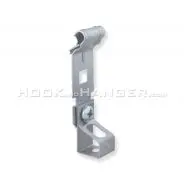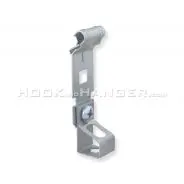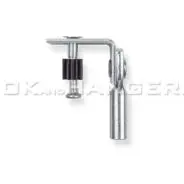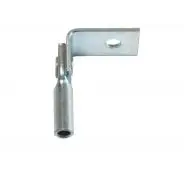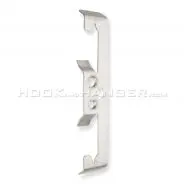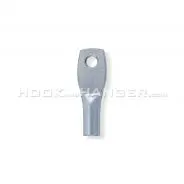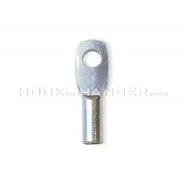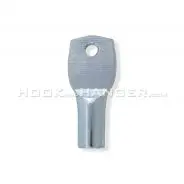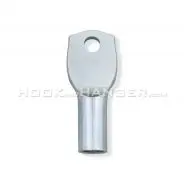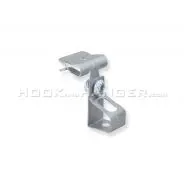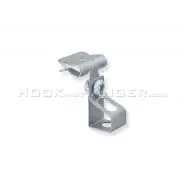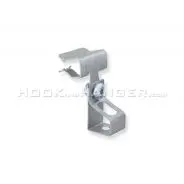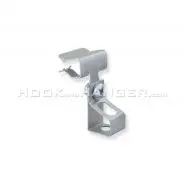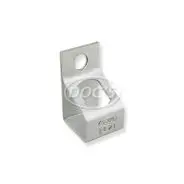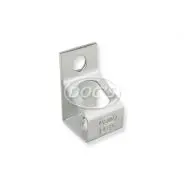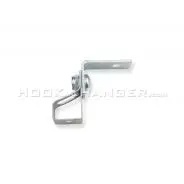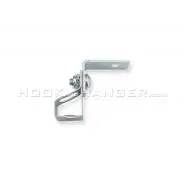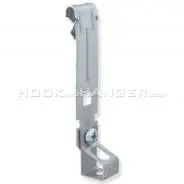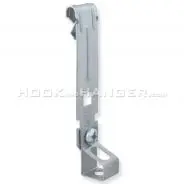
Threaded Rod Fasteners
Threaded rod fasteners are essential components in overhead construction and building systems. Designed to secure threaded rods in place, these fasteners enable safe suspension of ceilings, ductwork, cable trays, piping, and other mechanical or electrical systems. Whether used for light-duty hangers or heavy structural loads, threaded rod fasteners provide the strength, stability, and flexibility needed for precise, load-bearing installations.
These fasteners come in a wide range of types and sizes to suit various rod diameters, support materials, and application needs. From ceiling-mounted systems to industrial framing grids, choosing the right threaded rod fastener ensures not only a secure hold but also long-term performance and compliance with safety standards.
- Eye Coupling for 1/4" Threaded Rod - ¼"-20 Threaded Eyelet by Doc's Industries Inc. EC14-T
Starting at $0.90
- Eye Coupling for 3/8" Threaded Rod - ¼"-20 Threaded Eyelet by Doc's Industries Inc. EC38-T
Starting at $1.43
- Eye Coupling for 3/8" Threaded Rod with 1/4" Through Hole by Doc's Industries Inc. EC38As low as $1.43
- HOK2414TI - Hammer-on beam clamp assembled to 1/4"-20 threaded rod hanger clip by Doc's Industries Inc. HOK2414TIAs low as $1.57
- HOK2438TI - Hammer-on beam clamp assembled to 3/8"-16 threaded rod hanger clip by Doc's Industries Inc. HOK2438TIAs low as $1.59
- HOK5814TI - Hammer-on beam clamp assembled to 1/4"-20 threaded rod hanger clip by Doc's Industries Inc. HOK5814TIAs low as $1.77
- HOK5838TI - Hammer-on beam clamp assembled to 3/8"-16 threaded rod hanger clip by Doc's Industries Inc. HOK5838TIAs low as $1.78
Why Threaded Rod Fasteners Are Essential for Overhead Mounting
In many building environments, suspended systems are necessary to manage space, airflow, or cable routing above working areas. Threaded rods act as vertical supports in these setups, and threaded rod fasteners are the connecting points that lock them into place, either into ceilings, structural steel, concrete, or other anchoring surfaces.
Without properly rated fasteners, threaded rod installations can sag, shift, or fail under load. The purpose of these fasteners is not only to create a mechanical connection but to transfer loads safely through the support structure. They provide axial alignment for the rod, reduce unwanted movement, and offer flexible adjustability during installation.
Fasteners are available for both vertical and horizontal rod applications. Some models are designed for concrete anchors, others for beam clamps, channel nuts, or purlin clip attachments. Each plays a unique role in securing rods in different overhead environments, such as mechanical rooms, warehouses, data centers, and commercial fit-outs.
By simplifying the attachment process and ensuring code-compliant support, threaded rod fasteners are a critical part of safe, efficient building system installations.
Common Types of Threaded Rod Fasteners and Their Uses
Threaded rod fasteners come in various styles to meet the needs of specific mounting conditions. The most common type is the nut, which is typically hex-shaped and threaded internally to match the rod diameter. These are used in combination with washers to secure threaded rods at specific heights or points along a fixture.
Another key type is the rod hanger, which is a specialty fastener designed to support a vertical rod either from a beam, purlin, or concrete ceiling. Rod hangers may have a female thread to accept the rod directly or a male thread for embedding into a pre-drilled surface. Some hangers include clip-on or push-in features for tool-free installation in wire-hung grid systems or drop ceilings.
Beam clamps with threaded inserts are also widely used. These attach to steel beams or joists and provide a secure, load-rated point for threaded rod connection. They are especially useful when access to the beam is limited or when drilling is prohibited. The clamp tightens onto the beam flange, and the rod threads into the insert for clean suspension.
Channel nuts and spring nuts are used with strut channels to hold rods or threaded fittings in place. These fasteners are inserted into the channel and rotated to lock under tension, allowing for easy adjustment and a reliable grip inside the channel track.
Some applications also use coupling nuts, extended nuts that connect two threaded rods end to end. These allow for rod extensions or changes in rod direction using specialized hardware like angle brackets or pivot plates.
Material Options, Thread Sizes, and Installation Methods
Threaded rod fasteners are typically made from steel and come in a variety of finishes to suit different environments. Zinc-plated steel is the most common for indoor, dry locations. It offers general corrosion resistance and strong load-bearing performance for ceiling and electrical applications.
For higher moisture or exposed installations, hot-dip galvanized fasteners are recommended. These are ideal for use in HVAC systems, mechanical rooms, or partially open spaces where rust could compromise the integrity of the connection. In aggressive or chemical environments, stainless steel fasteners such as 304 or 316 grade provide long-term protection against corrosion and are commonly used in food processing, pharmaceutical, or marine facilities.
Thread sizes typically follow national standards such as UNC (Unified National Coarse). Common diameters include 1/4"-20, 3/8"-16, and 1/2"-13, depending on the weight being supported and the type of structure involved. It’s important to match the fastener thread pitch with the rod to avoid stripping or loosening during load application.
Installation methods vary by fastener type:
Standard nuts are hand-threaded and tightened with a wrench.
Rod hangers may be hammered or driven into place using a drill with a setting tool.
Beam clamps tighten with set screws or bolts and require access to the beam flange.
Strut channel fasteners are inserted and rotated to lock in the channel, often using spring-loaded features for easy placement.
Anchoring fasteners for concrete are typically set with expansion bolts or epoxy, then a threaded rod is installed afterwards. This is often part of an overhead drilling and anchoring process in structural ceilings or mechanical rooms.
Following the manufacturer's instructions for installation, torque, and load limits is essential to ensure safety and compliance.
Real-World Applications: Ceilings, Ducting, and Framing Systems
Threaded rod fasteners are used in a wide range of real-world construction and infrastructure projects. In suspended ceiling systems, fasteners connect rods to the structural ceiling and help hold T-bar grids, lighting fixtures, and air diffusers in place. They’re frequently paired with wire hangers, angle clips, or drop-in anchors, depending on the structure.In mechanical systems, fasteners secure rods that support ductwork, pipe runs, and air handling units. This is common in commercial buildings, hospitals, factories, and data centers. The fasteners used here must provide stable load transfer, minimize vibration, and accommodate vertical alignment.
In electrical and cable management installations, threaded rod fasteners anchor cable trays, ladder racks, and conduit systems to overhead supports. Their flexibility allows for modular builds and simplified adjustment if cable routing needs to change over time.
Framing and bracing applications also rely on rod fasteners. For example, seismic restraint systems or rigid structural frames may use fasteners to connect rods across multiple axis points, ensuring that load paths remain consistent even during movement or stress.
In industrial and retail settings, rods and fasteners may be used to suspend partitions, signage, or racking systems from ceiling trusses or beams. The wide variety of available hardware ensures compatibility with everything from wood and concrete to structural steel.
Choosing the Right Fastener for Your Rod Installation
When selecting a threaded rod fastener, the first step is identifying your installation surface and load requirements. Determine whether you’ll be anchoring into steel, concrete, wood, or using a support structure like strut channel or purlins. From there, choose a fastener type that’s designed for that mounting surface.
Next, match the fastener's thread size with your rod, ensuring the correct pitch and diameter for both structural compatibility and load performance. Consider the orientation of the rod: will it be suspended vertically, mounted horizontally, or extended between structures? Each setup may require different fasteners or support hardware.
Environmental conditions should also influence your choice. For dry, climate-controlled interiors, zinc-plated steel is usually sufficient. For areas with exposure to moisture or corrosive air, look for galvanized or stainless steel options.
Also, factor in accessibility and installation speed. Tool-free or snap-in fasteners can drastically reduce labor time in drop ceiling installations. Beam clamps and push-on clips make installation safer when working at height or in confined spaces.
Finally, always verify the load rating and compliance of each fastener. Manufacturers typically provide guidelines on maximum tension, shear load, and compatibility with specific rod sizes. Using rated hardware ensures your system will meet building codes and perform reliably over time.
For overhead mounting at height, fasteners can also be used with extension poles to improve safety and reduce ladder use during installation.
Need Help with Threaded Rod Fasteners or Bulk Orders?
Hook and Hanger offers a wide range of threaded rod fasteners, including rod hangers with threaded impressions, beam clamps with integrated rod clips, TI hangers, and eye couplings for both 1/4"-20 and 3/8"-16 rod sizes. We also stock purlin clips and joist clips assemblies pre-fitted with threaded rod hangers for fast, secure installation. Whether you're supporting ceiling wire, cable trays, or ducting, our fasteners are designed for compatibility and safe overhead suspension.
If you’re unsure which type fits your job or need help with flange size, thread type, or pack quantities, feel free to reach out. Our team is here to help you find the right solution for your application or assist with bulk pricing and order guidance.

